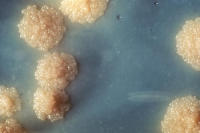Tuberculosis
 Overview
Overview
Nearly two million people each year around the world die from tuberculosis, or TB. Approximately ten million new cases are diagnosed annually, and more strains of TB are becoming resistant to the drugs that are used for treatment.
Up to one-third of the world's population might be infected with the bacteriaum that eventually can cause TB. Most, however, will never develop the active stage of tuberculosis.
Causes of Tuberculosis
TB is caused by a specific airborne bacterium (mycobacterium tuberculosis) which typically infects the lungs. It can take several exposures over a long period of time for the actual infection to occur. When a person with active tuberculosis coughs, sneezes or speaks, the bacteria are released into the air, where they can survive for hours. Other people will inhale these bacteria, but most will be protected by their immune system. Some will become infected, but only 10 percent or less will develop the active stage of TB, perhaps many years later when their immune system weakens due to illness, age or other conditions. These people are not contagious until that hapenns. Some of these people, such as those with AIDS, will develop TB sooner due to their weakened immune systems.
Prevention
The spread of tuberculosis in crowded places such as clinics and hospitals can be prevented by adequate ventilation and the use of ultraviolet light to kill the airborne bacteria. Drugs (such as isoniazid) can help prevent the disease from becoming active in those who have a TB infection. A vaccine called BCG is used for high-risk populations in underdeveloped areas, but its effectiveness and use are still quite controversial.
Any people who are diagnosed with tuberculosis should remain in isolation for the beginning stages of treatment (one to two weeks), or until the coughing stops and the danger of contagion has been greatly reduced.
Diagnosis
Anyone who has been exposed to TB should seek immediate medical treatment from a health care professional. Anyone whose immune system is able to isolate the tuberculosis bacteria will not show any symptoms. Those individuals who have active TB might not feel sick, or they may have a persistent cough, loss of appetite, weight loss, fever, night sweats, fatigue and blood in the phlegm which is coughed up.
A skin test can show whether the infection is actually present in the body. Chest x-rays, as well as cultures and microscopic examination of sputum, are necessary to confirm that the disease is active.
Treatments
In our modern world, antibiotics can effectively be used to treat most cases of tuberculosis. TB which is multi-drug resistant is much harder to treat because the bacteria cannot be killed by several of the drugs typically used for this illness. This type of TB can spread easily and is dangerous. This version of tuberculosis is most commonly seen in the strains found in Africa and Asia.
Those at Risk
The people most at risk for contracting tuberculosis include people who are:
- Suffering from an impaired immune system
- Diagnosed with HIV/AIDS
- Suffering from malnutrition
- Residents of long-term care facilities
- Malnourished
- IV drug users
- Elderly or very young
- Health care workers and prison guards
Treatments
In addition to traditional medical treatments, several herbs can be used to treat tuberculosis. They include:
- Echinacea - This herb is good for combating any bacteria, including the type that causes TB. Echinacea will help boost the immune system.
- Forsythia - The Chinese use forsythia as an antibacterial antiseptic. Strong teas (such as those made from this plant) can be very active against several types of bacteria. Forsythia has been used clinically to fight tuberculosis, along with honeysuckle.
- Garlic - The Chinese use garlic to treat TB. Anyone who fears they have been exposed to tuberculosis could take at least one garlic capsule per day. Recent research suggests that garlic may help antibiotics in their battle against tuberculosis.
- Honeysuckle - This flower has been used in China for centuries to treat a variety of respiratory illnesses, including tuberculosis, bronchitis, pneumonia, flu and colds.
- Licorice - On a dry-weight basis, licorice has up to 33 percent antibacterial compounds. The Chinese frequently use licorice to treat TB. Licorice tea can be effective against many illnesses, including tuberculosis and Lyme disease.
- Eucalyptus - This herb is also used in Asia to treat tuberculosis. Although fresh eucalyptus may be hard to find, essential oil can also be used. While essential oils typically cannot be ingested, eucalyptus is an exception to this rule.
- Onion - Onions have almost as much antibacterial action as its relative, garlic. TB sanatorium residents often eat onions as well as garlic.
References
- Bratman, S. The Alternative Medicine Ratings Guide: an expert panel rates the best treatments for over 80 conditions, Prima Health A Division of Prima Publishing (1998)
- Brown, L. Alternative Medicine, NTC/Contemporary Publishing (1999)
- Deepak Chopra, M.D. Alternative Medicine: The Definitive Guide, Celestial Arts (2002)
- Judd, S. (2008). Respiratory disorders sourcebook : basic consumer health information about infectious, inflammatory, and chronic conditions affecting the lungs and respiratory system, including pneumonia, bronchitis, influenza, tuberculosis, sarcoidosis, asthma, cystic fibrosis, chronic obstructive pulmonary disease, lung abscesses, pulmonary embolism, occupational lung diseases, and other bacterial, viral, and fungal infections; along with facts about the structure and function of the lungs and airways, methods of diagnosing respiratory disorders, and treatment and rehabilitation options, a glossary of related terms, and a directory of resources for additional help and information. Detroit, MI : Omnigraphics
- Servan-Schreiber, D. The Encyclopedia of New Medicine: Conventional & Alternative Medicine For All Ages, Rodale International Limited (2006)
Posted in Tuberculosis
Ask a Question Or Join a Discussion


